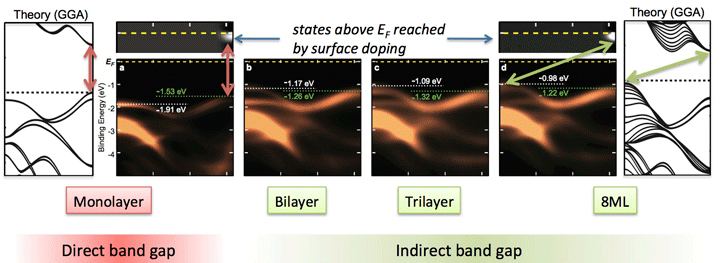Using novel materials to develop thin, flexible, and more efficient photovoltaic cells is one of the hottest topics in current materials research. Transition-metal dichalcogenides,* such as MoS2, MoSe2, WS2, WSe2, have recently attracted a lot of attention in this effort. A growing number of studies suggest that the electronic properties of these materials go through a dramatic change that makes them ideal for solar energy applications. These materials can go from indirect band-gap semiconductors to direct band-gap semiconductors when their thickness reduces to a single-layer limit with the sizes of the band gap in the red to near-infrared spectrum, characteristics that are extremely advantageous for light-harvesting and light-detecting applications. Up until now however, researchers have not been able to make direct and detailed observation of how this transition occurs.
Using the molecular-beam epitaxial thin-film-growth capability at ALS Beamline 10.0.1, scientists have successfully grown high-quality thin film samples of MoSe2 with layer-by-layer control of thickness down to a single layer. The films were characterized using in situ angle-resolved photoemission on Beamline 10.0.1, where for the first time, researchers were able to directly observe the indirect-to-direct band-gap transition. These photoemission results indicate a stronger tendency of single-layer MoSe2 towards a direct band gap—with a larger gap size—than theoretically predicted. The ability to successfully produce uniform, large-size samples, and the observation of exact electronic structure and gap evolution with varying thickness, are huge steps on the design path to more efficient solar cells.
*dichalcogenide: Any chalcogenide containing two atoms of chalcogen (any of group 16 of the periodic table: oxygen, sulphur, selenium, tellurium, and polonium) per molecule or unit cell

Work performed at ALS Beamline 10.0.1.
Y. Zhang, T.-R. Chang, B. Zhou, Y.-T. Cui, H. Yan, Z. Liu, F. Schmitt, J. Lee, R. G. Moore, Y. L. Chen, H. Lin, H.-T. Jeng, S.-K. Mo, Z. Hussain, A. Bansil, and Z.-X. Shen, “Direct observation of the transition from indirect to direct band gap in atomically-thin epitaxial MoSe2,” Nat. Nanotechnol. 9, 111 (2014), doi:10.1038/nnano.2013.277.
See also the SLAC news feature, “Scientists from SIMES and Berkeley Lab Cook Up New Electronic Material.”